 |
 |
 |
| |
Pilot Study to Evaluate Intramyocardial Lipid Accumulation in HIV+ Patients Receiving Highly Active Antiretroviral Therapy (HAART)
|
| |
| |
IDSA: Higher Intramyocardial Lipids in Antiretroviral-Treated Men Than in HIV-Negatives - written by Mark Mascolini - (10/04/13)
The investigators observed that cardiac steatosis (fat build-up from abnormal lipid retention) has been linked to several Framingham risk factors, including diabetes, hypertension, and abnormal plasma lipids. People with cardiac steatosis have increased stroke volume and heart rate [2]. One hypothesis explaining how metabolic changes lead to cardiovascular disease, the researchers noted, involves over-storage of lipids and lipotoxic injury to heart muscle [3,4]. ....The researchers proposed that "this increase in cardiac lipids may contribute to or be associated with an increased risk of cardiovascular disease, including end-stage heart failure in this [HIV-positive] patient population."
Reported by Jules Levin
IDSA/IDWeek Oct 2-6 2013 San Francisco, CA
Presenting Author: David Tellalian, M.D.
L. Szczepaniak, PhD, M.D. Nelson, PhD, C. Paterson, MD, K. McElroy, MD, E. Sczepaniek, PhD, T. LaBounty, MD, J. Hsih, MD, L. Smith, J. Gottlieb, BS, D. Ramirez, BS, D. Li, PhD, W.D. Hardy, MD, R. Yumul, MD, PhD, A. Hernandez Conte, MD, MBA
Departments of Anesthesiology, Infectious Diseases, & Biomedical Imaging Research Institute, Cedars-Sinai Medical Center, Los Angeles, CA
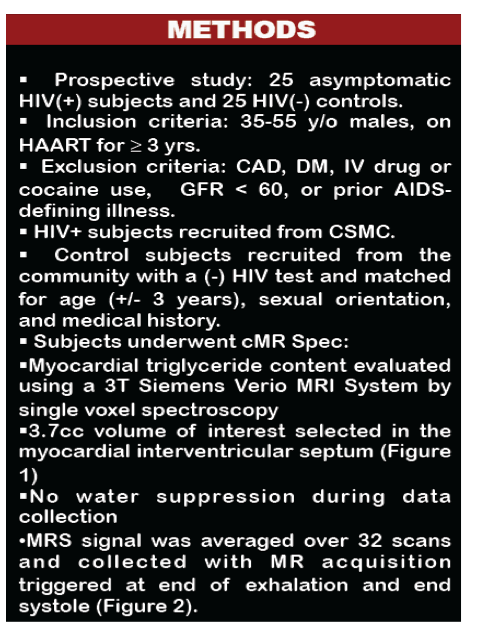
Program Abstract
Background: Approximately 55,000 persons become infected with the human immunodeficiency virus (HIV) in the United States annually. Early HAART regimens have commonly been associated with the lipodystrophy syndrome including hyperlipidemia and fat redistribution. The purpose of this study is to quantitate intramyocardial lipid accumulation in a group of HIV (+) patients receiving HAART using cardiac magnetic resonance spectroscopy (cMR Spec).
Methods: This is a prospective pilot study of 25 asymptomatic HIV (+) subjects and 25 HIV (-) controls. For cases, inclusion criteria: 35-55 years of age; HAART for ≥ 3 years. Exclusion criteria: known cardiovascular disease, current smoking, diabetes history, IV drug use, GFR < 60 ml/min, or prior AIDS-defining illness. For controls: confirmed negative HIV EIA; matched to cases for age (+/- 3 years), sexual orientation and medical history. Subjects underwent cMR Spec, along with detailed medical history, HIV and HAART history, physical exam including hip/waist ratio, lipid testing, and inflammatory lab tests.
Results: Among HIV(+) subjects, mean duration of HIV infection was 17 years (range 5-28 years); mean duration of antiretroviral therapy was -13 years (range 3-26 years). Preliminary results: Intramyocardial lipid accumulation was found to be- HIV (+) subjects (n=19), Median = 0.87% (range = 0 to 4.28 %) versus HIV (-) controls (n=17), Median = 0.25% (range = 0 to 3.87%). Correlations of these data with biomarkers of lipodystrophy, including lipid levels, hip/waist ratio, and antiretroviral history are currently under investigation and will be presented.
Conclusion: Our study, using cMR Spec, demonstrates a higher percentage of intracardiac lipid accumulation, as well as a higher volume of epidcardial fat, among HIV+ subjects on HAART compared to HIV(-) controls. This increase in cardiac lipid may contribute to or be associated with an increased risk of cardiovascular disease, including end-stage heart failure in this patient population. Further investigation is needed in order to determine the impact and long-term sequelae of myocardial lipid accumulation in HIV+ patients on HAART.

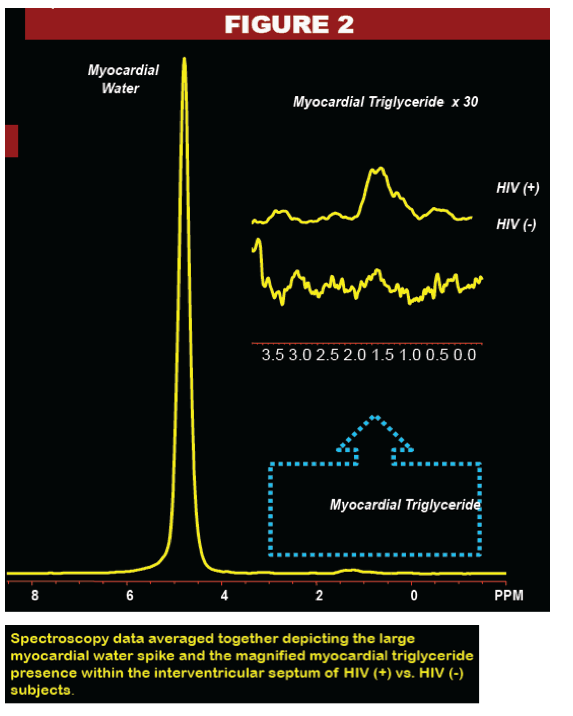
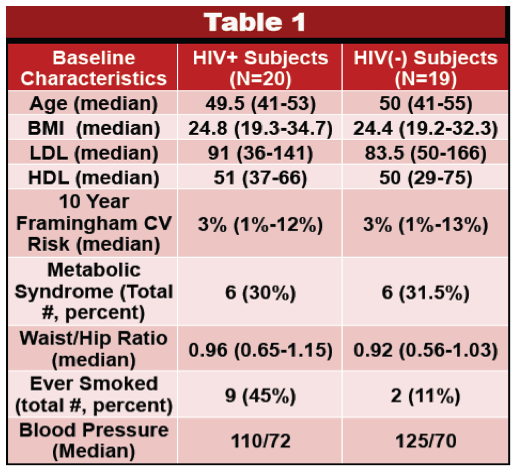
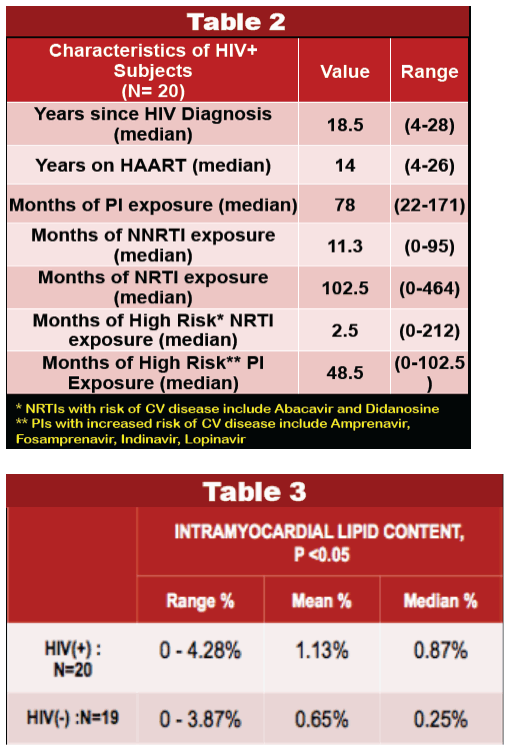
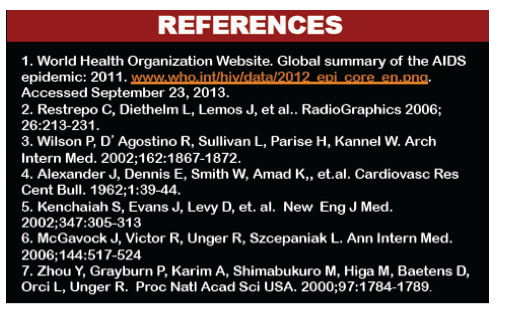
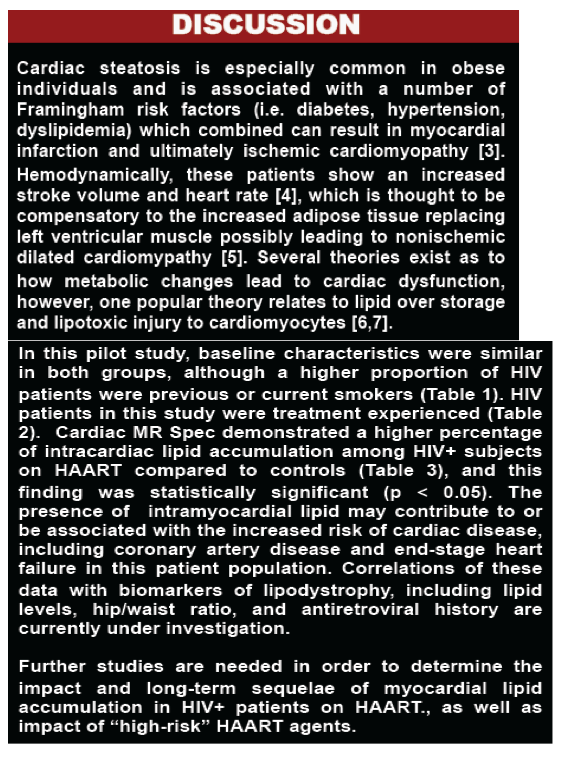
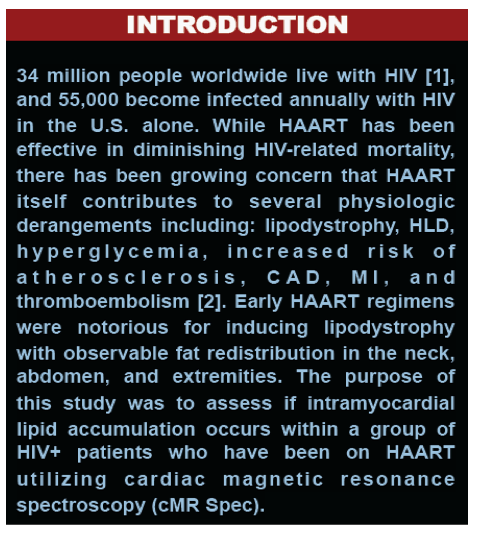
|
| |
|
 |
 |
|
|